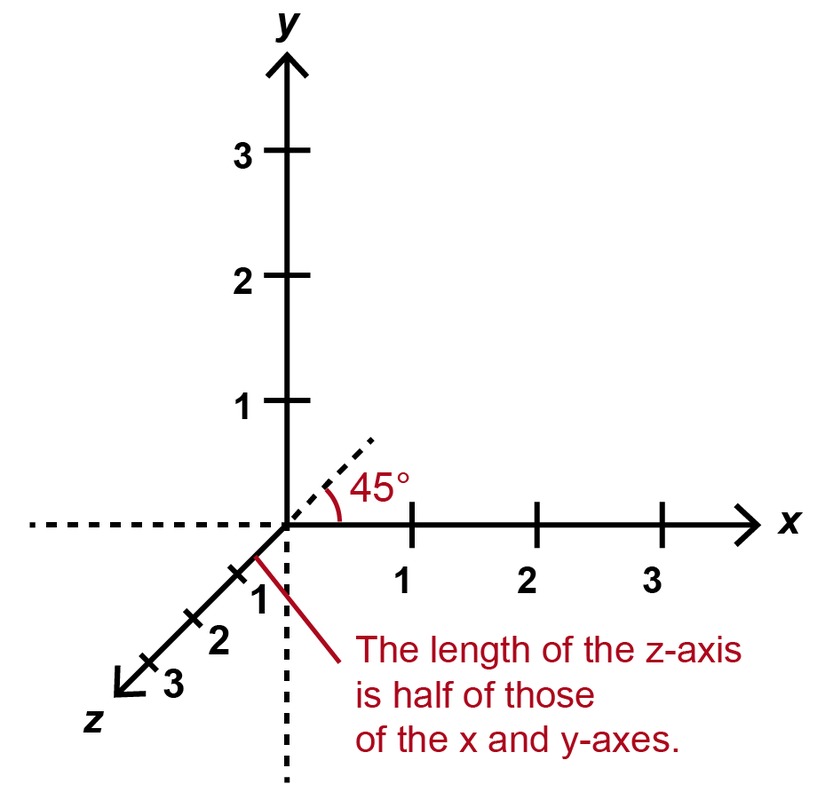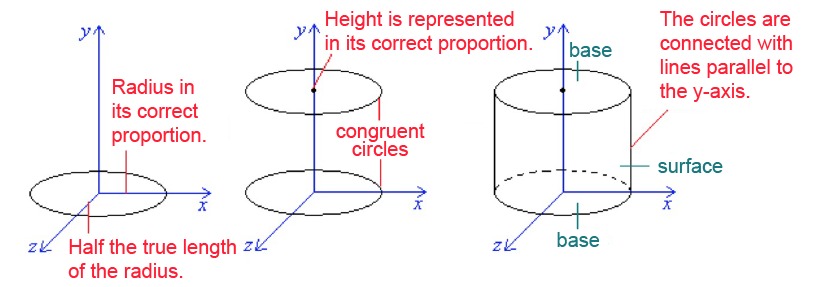7. Classifying and drawing objects
Classifying and drawing objects
 Because objects in the real world are three-dimensional, it is tricky to draw them on two-dimensional paper. In mathematics, the cavalry perspective and the cartesian coordinate system are usually used. In it, the [[$ x $]] and [[$ y $]] axes are drawn perpendicular to one another. The three-dimensional effect is performed on the [[$ z $]] axis, which is placed at a 45 ° angle with the [[$ x $]] and [[$ y $]] axes. For the [[$ z $]] axis to appear to come out of the paper, its axis lengths are half the corresponding lengths of the [[$ x $]] and [[$ y $]] axes.
Because objects in the real world are three-dimensional, it is tricky to draw them on two-dimensional paper. In mathematics, the cavalry perspective and the cartesian coordinate system are usually used. In it, the [[$ x $]] and [[$ y $]] axes are drawn perpendicular to one another. The three-dimensional effect is performed on the [[$ z $]] axis, which is placed at a 45 ° angle with the [[$ x $]] and [[$ y $]] axes. For the [[$ z $]] axis to appear to come out of the paper, its axis lengths are half the corresponding lengths of the [[$ x $]] and [[$ y $]] axes.
In this three-dimensional coordinate system, the negative parts of the axes (drawn in dashed lines in the figure) are omitted, so that the image does not become too confusing.
Cylinders
A cylinder has two parallel and congruent bases and a lateral surface. In a straight cylinder, the lateral surface is perpendicular to the base. All other kinds of cylinders are considered oblique cylinders. If the bottom of the cylinder is a circle, the cylinder is called a circular cylinder. If the bottom of the cylinder is a polygon, the cylinder is called a prism.

In a right polyhedron, all edges and faces are perpendicular to each other and all of the cylinder's faces are rectangles. A cube is a right polyhedron in which all faces are squares.
If the polygon at the base of the cylinder is a triangle, we speak of a triangle with sides. If the bases are rectangles, we are talking about a quadrilateral polyhedron. If the base pattern of a right polyhedron is a regular polygon, then it is considered a regular polyhedron.

Cones
A cone has a single base, a peak and a surface between them. The surface of a cone is called a lateral surface. Like a cylinder, a cone can be either straight or oblique. If the base of a cone is a circle, it is called a circular cone. If the base of a cone is a polygon, the cone is called a pyramid. A cone is a regular cone if its base is regular and if its height line coincides with the center of the base.

Exercises
2/07. Exercise 7.01
2/07. Exercise 7.02
2/07. Exercise 7.03
2/07. Exercise 7.04
2/07. Exercise 7.05
2/07. Exercise 7.06
2/07. Exercise 7.07
2/07. Exercise 7.08
2/07. Exercise 7.09
2/07. Exercise 7.10
2/07. Exercise 7.11
2/07. Exercise 7.12
2/07. Exercise 7.13
2/07. Exercise 7.14
2/07. Exercise 7.15
2/07. Exercise 7.16
2/07. Submission folder for answers
Sinulla ei ole tarvittavia oikeuksia lähettää mitään.